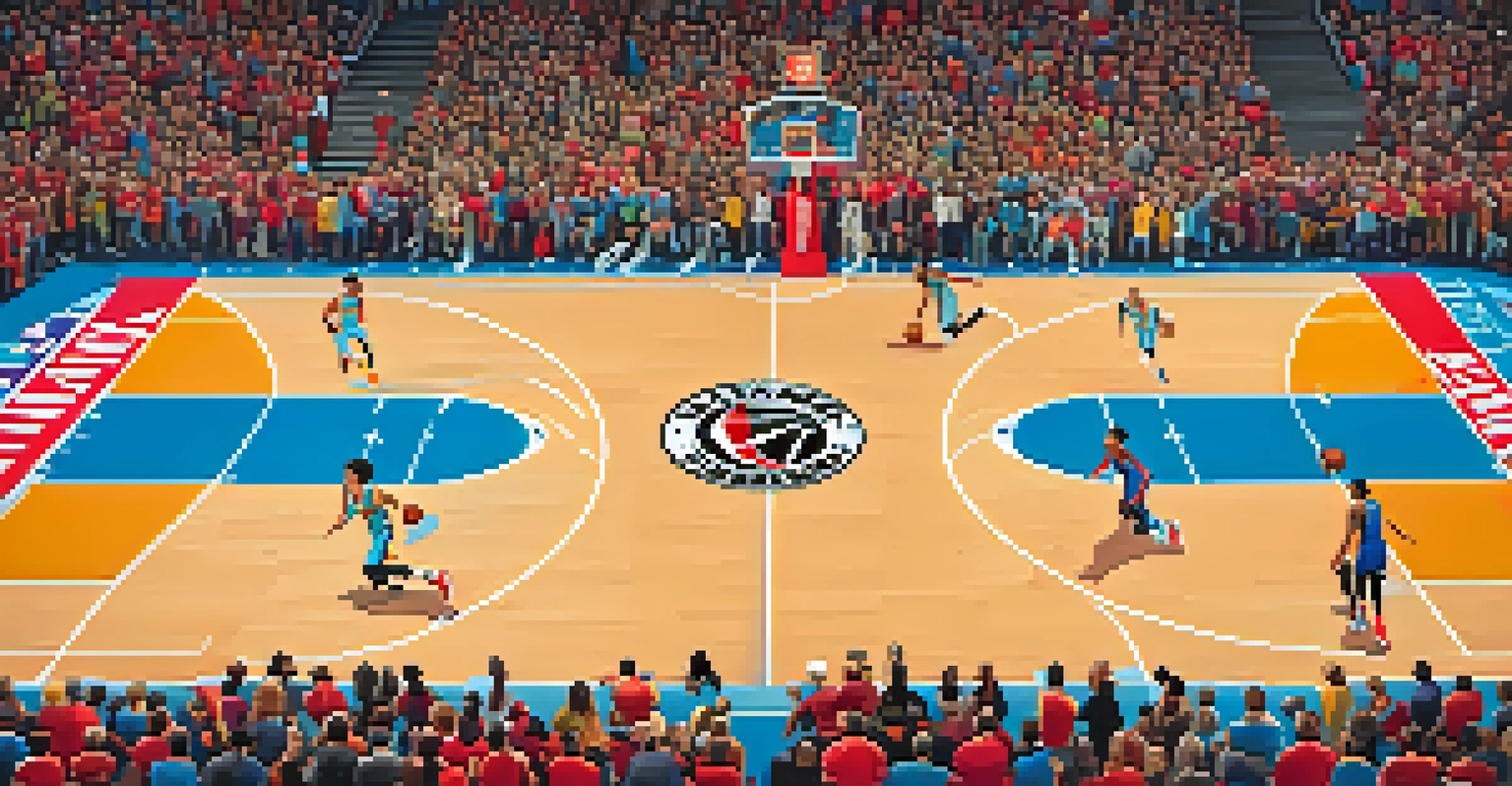Atlanta Hawks: An In-Depth Look at Their NBA Evolution

The Origins: How the Atlanta Hawks Came to Be
The Atlanta Hawks began their journey in 1946 as the Buffalo Bisons, showcasing the team's early ambition to make a mark in professional basketball. After a series of relocations, the franchise settled in Atlanta in 1968, becoming a crucial part of the city's sports culture. This shift not only brought the Hawks closer to a larger fan base but also helped them to craft a unique identity in the NBA.
Success is no accident. It is hard work, perseverance, learning, studying, sacrifice and most of all, love of what you are doing or learning to do.
In Atlanta, the Hawks quickly became a favorite among basketball fans, thriving in a city that was becoming a cultural hub. The team's first major success came in the early 1980s, with stars like Dominique Wilkins leading the charge. His electrifying style of play not only drew crowds but also put the Hawks firmly on the NBA map.
The franchise's early years were marked by various ups and downs, but they laid the foundation for a passionate fan base. The integration of local culture with the team’s identity began here, setting the stage for the Hawks' evolution and their connection with Atlanta's vibrant community.
Dominique Wilkins: The Human Highlight Film
Dominique Wilkins, often referred to as 'The Human Highlight Film,' is perhaps the most iconic player in Atlanta Hawks history. His tenure with the team from 1982 to 1994 was marked by jaw-dropping dunks and a fierce competitive spirit that resonated with fans. Wilkins not only redefined the small forward position but also brought an exciting brand of basketball that kept fans on the edge of their seats.

During his time with the Hawks, Wilkins earned numerous accolades, including multiple All-Star selections and the 1994 NBA scoring title. His ability to perform in clutch moments made him a beloved figure in Atlanta. More than just statistics, his passion for the game inspired a generation of players and fans alike.
Hawks' Legacy Rooted in Community
The Atlanta Hawks have forged a strong connection with their fans and local culture, shaping their identity since relocating to Atlanta in 1968.
Wilkins' legacy continues to influence the team's culture today, as his dedication and artistry on the court set a high standard for future Hawks players. Whether it was his highlight-reel dunks or his leadership, Wilkins became synonymous with Hawks basketball, creating a lasting imprint on the franchise's history.
The 1990s: A Decade of Promise and Challenge
The 1990s were a mixed bag for the Atlanta Hawks, filled with promise yet often falling short in critical moments. With a roster that included stars like Dikembe Mutombo and Steve Smith, the team consistently reached the playoffs but struggled to make deep runs. The Hawks showcased their talent during this era, yet they frequently faced formidable opponents, limiting their postseason success.
The only way to prove that you’re a good sport is to lose.
Despite the challenges, the 90s also saw the Hawks establishing themselves as a competitive force in the Eastern Conference. The team made several playoff appearances and was known for its defensive prowess, largely thanks to Mutombo's rim protection. This period was crucial for building a competitive identity, even if it didn’t always translate into championship success.
As the decade progressed, the Hawks began to redefine their strategy, focusing on acquiring players who could elevate the team to new heights. The lessons learned during this era laid the groundwork for future success and helped shape the franchise's direction in the years to come.
The 2000s: A Rebuilding Phase
The 2000s proved to be a tumultuous time for the Atlanta Hawks, as the team entered a rebuilding phase that tested the loyalty of its fans. After the departure of key players, the Hawks struggled to find their footing in a competitive league. However, this period also opened doors for young talent, with the likes of Joe Johnson and Al Horford beginning to emerge as franchise cornerstones.
Despite the struggles, the Hawks managed to build a solid foundation during these years, focusing on developing young players and establishing a cohesive team dynamic. The 2008 season marked a turning point, as the team made the playoffs for the first time in several years, signaling a return to relevance in the NBA landscape.
Dominique Wilkins Defined an Era
As 'The Human Highlight Film,' Dominique Wilkins not only became an icon for the Hawks but also set a standard for passion and performance in the franchise's history.
The 2000s ultimately laid the groundwork for a resurgence, demonstrating the importance of patience and strategic planning in sports. The Hawks' ability to navigate through these challenging times helped cultivate a resilient team culture, which would be crucial for their future successes.
The Rise of the New Hawks: 2010s Success
The 2010s marked a renaissance for the Atlanta Hawks, as the team embraced a new identity and enjoyed significant success. With a core group of players, including Paul Millsap and Al Horford, the Hawks transformed into a formidable force in the Eastern Conference. The highlight of this era came in the 2014-2015 season when they achieved a franchise-record 60 wins and secured the top seed in the playoffs.
This period was characterized by a selfless brand of basketball, emphasizing ball movement and teamwork over individual accolades. The Hawks became known for their unselfish play, earning praise for their chemistry on the court. Fans rallied around this new style, revitalizing the city’s connection to the team and reigniting excitement for Hawks basketball.
The success of the 2010s not only solidified the Hawks' place in the NBA but also set the stage for future generations of players. This era proved that with the right mix of talent, teamwork, and a strong fan base, the Hawks could compete at the highest level, creating a legacy that would inspire years to come.
The Trae Young Era: A New Chapter Begins
The arrival of Trae Young in 2018 marked the dawn of a new chapter for the Atlanta Hawks, as the young star quickly became the face of the franchise. Known for his scoring ability and playmaking skills, Young has drawn comparisons to some of the game's greatest players. His electrifying performances captivate fans and instill hope for a bright future.
Under Young's leadership, the Hawks experienced a resurgence, reaching the Eastern Conference Finals in 2021—a feat that energized the city and its fan base. The team’s ability to rally around Young's talent demonstrated the importance of having a franchise player who could elevate the entire roster. His on-court vision and deep shooting range have transformed the team's offensive strategy.
Trae Young Leads Future Aspirations
The emergence of Trae Young as the face of the franchise marks a promising new chapter, with the potential for the Hawks to become championship contenders.
The Trae Young era represents a blend of youth and experience, as the Hawks continue to build around their star point guard. With a mix of talented players and a supportive coaching staff, the franchise is poised for sustained success in the coming years, and fans are excited to see what the future holds.
The Future: What Lies Ahead for the Hawks?
As the Atlanta Hawks look to the future, the franchise is focused on building a championship-caliber team around Trae Young and his supporting cast. The front office is committed to making strategic moves to enhance the roster, whether through trades, drafts, or free agency. The goal is clear: to transform the team's recent success into long-term sustainability.
With a young and talented core, the Hawks have the potential to compete for titles in the years to come. The team’s commitment to developing talent and fostering a collaborative culture bodes well for their future. As they continue to evolve, the Hawks aim to blend experience with youth, creating a dynamic team that can adapt to the challenges of the NBA.

Fans can expect to see an exciting brand of basketball, filled with high-scoring games and thrilling plays. The Atlanta Hawks are not just looking to make the playoffs; they are determined to become a perennial contender in the league, seeking to bring an NBA championship to Atlanta for the first time.